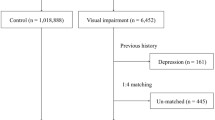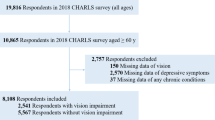Abstract
Background
Vision impairment (VI) and depression are highly prevalent among adults. However, few nationally representative studies from China on the self-reported VI and its association with depression symptoms.
Aims
This study re-estimated the relationship between self-reported VI and depression symptoms.
Methods
In this analysis, 62,525 respondents from the China Health and Retirement Longitudinal Study 2011–2018 were included. Based on self-reports, respondents with VI were allocated to distance VI (DVI), near VI (NVI), both distance and near VI (DNVI), or a blindness group. Multivariable pooled logistic regression models were used to evaluate the groups' odds ratios (ORs) for depression symptoms and self-reported VI.
Results
Overall, 35.9% of the respondents were self-reported VI. DVI (OR: 1.51, 95% confidence interval [95% CI]: 1.28–1.79) and DNVI (OR: 1.51, 95% CI: 1.21–1.88) showed the highest ORs for depression symptoms, followed by NVI (OR: 1.31, 95% CI: 1.11–1.54). Depression symptoms were associated with a significantly increased risk of DVI (OR: 1.49, 95% CI: 1.26–1.76), DNVI (OR: 1.49, 95% CI: 1.20–1.86), and NVI (OR: 1.29, 95% CI: 1.10–1.52), respectively. However, these associations between self-reported blindness and depression symptoms were not significant. All models provided similar results by excluding respondents aged 45–59 years.
Conclusion
Self-reported DVI, NVI, and DNVI are associated with depression symptoms. A strong reverse association was found between depression and self-reported DVI, NVI, and DNVI, but not for blindness. Our findings emphasize the urgent need for depression screening for self-reported VI among Chinese adults.


Similar content being viewed by others
Data availability
All data used in this research were sourced from the China Health and Retirement Longitudinal Study, 2011–2018. The data are openly available here: http://charls.pku.edu.cn/pages/data/111/zh-cn.html (accessed 11 May 2021).
References
Lopez AD, Mathers CD (2006) Measuring the global burden of disease and epidemiological transitions: 2002–2030. Ann Trop Med Parasitol 100:481–499. https://doi.org/10.1179/136485906x97417
Vos T, Lim SS, Abbafati C et al (2020) Global burden of 369 diseases and injuries in 204 countries and territories, 1990–2019: a systematic analysis for the global burden of disease study 2019. Lancet 396:1204–1222. https://doi.org/10.1016/s0140-6736(20)30925-9
Frick KD, Joy SM, Wilson DA et al (2015) The global burden of potential productivity loss from uncorrected presbyopia. Ophthalmology 122:1706–1710. https://doi.org/10.1016/j.ophtha.2015.04.014
WHO (2013) Universal Eye Health: A Global Action Plan 2014–2019
WHO (2019) World report on vision. https://www.who.int/publications/i/item/9789241516570. Accessed 16 May 2020
Flaxman SR, Bourne RR et al (2017) Global causes of blindness and distance vision impairment 1990–2020: a systematic review and meta-analysis. Lancet Glob Health 5:e1221–e1234. https://doi.org/10.1016/s2214-109x(17)30393-5
United Nations (2019) World population prospects 2019: highlights. Department of economic and social affairs, population division.
Brown RL, Barrett AE (2011) Visual impairment and quality of life among older adults: an examination of explanations for the relationship. J Gerontol B Psychol Sci Soc Sci 66:364–373. https://doi.org/10.1093/geronb/gbr015
Hreha KP, Downer B, Ehrlich JR et al (2021) Association between vision impairment and cognitive decline in older adults with stroke: health and retirement study. Aging Clin Exp Res 33:2605–2610. https://doi.org/10.1007/s40520-020-01776-w
Rees G, McCabe M, Xie J et al (2020) High vision-related quality of life indices reduce the odds of depressive symptoms in aged care facilities. Aging Ment Health 24:1596–1604. https://doi.org/10.1080/13607863.2019.1650889
Swenor BK, Lee MJ, Varadaraj V et al (2020) Aging with vision loss: a framework for assessing the impact of visual impairment on older adults. Gerontologist 60:989–995. https://doi.org/10.1093/geront/gnz117
Bernabei V, Morini V, Moretti F et al (2011) Vision and hearing impairments are associated with depressive–anxiety syndrome in Italian elderly. Aging Ment Health 15:467–474. https://doi.org/10.1080/13607863.2011.562483
Bookwala J, Lawson B (2011) Poor vision, functioning, and depressive symptoms: a test of the activity restriction model. Gerontologist 51:798–808. https://doi.org/10.1093/geront/gnr051
Gong X, Ni Z, Wu B (2020) The mediating roles of functional limitations and social support on the relationship between vision impairment and depressive symptoms in older adults. Ageing Soc 40:465–479. https://doi.org/10.1017/s0144686x18001010
Lundeen EA, Saydah S, Ehrlich JR et al (2021) Self-reported vision impairment and psychological distress in US Adults. Ophthal Epidemiol. https://doi.org/10.1080/09286586.2021.1918177
Carrière I, Delcourt C, Daien V et al (2013) A prospective study of the bi-directional association between vision loss and depression in the elderly. J Affect Disord 151:164–170. https://doi.org/10.1016/j.jad.2013.05.071
Naël V, Pérès K, Dartigues JF et al (2019) Vision loss and 12-year risk of dementia in older adults: the 3C cohort study. Eur J Epidemiol 34:141–152. https://doi.org/10.1007/s10654-018-00478-y
Abou-Hanna JJ, Leggett AN, Andrews CA et al (2021) Vision impairment and depression among older adults in low- and middle-income countries. Int J Geriatr Psychiatry 36:64–75. https://doi.org/10.1002/gps.5394
Frank CR, Xiang X, Stagg BC et al (2019) Longitudinal associations of self-reported vision impairment with symptoms of anxiety and depression among older adults in the United States. JAMA Ophthalmol 137:793–800. https://doi.org/10.1001/jamaophthalmol.2019.1085
Crews JE, Chou CF, Sekar S et al (2017) The prevalence of chronic conditions and poor health among people with and without vision impairment, aged ≥ 65 years, 2010–2014. Am J Ophthalmol 182:18–30. https://doi.org/10.1016/j.ajo.2017.06.038
Bibring E (1953) The mechanism of depression. In: Greenacre P (ed) Affective Disorders: Psychoanalytic Contributions to Their Study. International Universities Press, NY, pp 13–48
Burton MJ, Ramke J, Marque AP et al (2021) The lancet global health commission on global eye health: vision beyond 2020. Lancet Glob Health 9:e489–e551. https://doi.org/10.1016/s2214-109x(20)30488-5
Peking University (2020) the National Natural Science Foundation of China. China Health and Retirement Longitudinal Survey (CHARLS). http://charls.pku.edu.cn/pages/data/111/zh-cn.html. Accessed 11 May 2021
Zhao Y, Hu Y, Smith JP et al (2014) Cohort profile: the China health and retirement longitudinal study (CHARLS). Int J Epidemiol 43:61–68. https://doi.org/10.1093/ije/dys203
Saaddine JB, Narayan KM, Engelgau MM et al (1999) Prevalence of self-rated visual impairment among adults with diabetes. Am J Public Health 89:1200–1205. https://doi.org/10.2105/ajph.89.8.1200
Andresen EM, Malmgren JA, Carter WB et al (1994) Screening for depression in well older adults: evaluation of a short form of the CES-D (center for epidemiologic studies depression scale). Am J Prev Med 10:77–84. https://doi.org/10.1016/S0749-3797(18)30622-6
Zhong Y, Wang J, Nicholas S (2017) Gender, childhood and adult socioeconomic inequalities in functional disability among Chinese older adults. Int J Equity Health 16:165. https://doi.org/10.1186/s12939-017-0662-3
D’Agostino RB, Lee ML, Belanger AJ et al (1990) Relation of pooled logistic regression to time dependent Cox regression analysis: the Framingham heart study. Stat Med 9:1501–1515. https://doi.org/10.1002/sim.4780091214
Ngwa JS, Cabral HJ, Cheng DM et al (2016) A comparison of time dependent Cox regression, pooled logistic regression and cross sectional pooling with simulations and an application to the Framingham heart study. BMC Med Res Methodol 16:1–12. https://doi.org/10.1186/s12874-016-0248-6
Keele L, Kelly NJ (2006) Dynamic models for dynamic theories: the ins and outs of lagged dependent variables. Polit Anal 14:186–205. https://doi.org/10.1093/pan/mpj006
Herrman H, Kieling C, McGorry P et al (2019) Reducing the global burden of depression: a lancet-world psychiatric association commission. Lancet 393:e42–e43. https://doi.org/10.1016/S0140-6736(18)32408-5
Hamby DM (1995) A comparison of sensitivity analysis techniques. Health Phys 68:195–204. https://doi.org/10.1097/00004032-199502000-00005
Coyle CE, Steinman BA, Chen J (2017) Visual acuity and self-reported vision status. J Aging Health 29:128–148. https://doi.org/10.1177/0898264315624909
Santini ZI, Jose PE, Koyanagi A et al (2021) The moderating role of social network size in the temporal association between formal social participation and mental health: a longitudinal analysis using two consecutive waves of the survey of health, ageing and retirement in Europe (SHARE). Soc Psychiatry Psychiatr Epidemiol 56:417–428. https://doi.org/10.1007/s00127-020-01961-2
Williamson GM, Shaffer DR (2002) The activity restriction model of depressed affect. In: Williamson GM, Shaffer DR, Parmelee PA (eds) Physical illness and depression in older adults: a handbook of theory, research, and practice. Kluwer Academic Publishers, NY, pp 173–200
Cho GE, Lim DH, Baek M et al (2015) Visual impairment of Korean population: prevalence and impact on mental health. Invest Ophthalmol Vis Sci 56:4375–4381. https://doi.org/10.1167/iovs.15-16462
Rovner BW, Casten RJ, Tasman WS (2002) Effect of depression on vision function in age-related macular degeneration. Arch Ophthalmol 120:1041–1044. https://doi.org/10.1001/archopht.120.8.1041
Pongsachareonnont P, Uramphorn N, Hounnaklang N (2018) Association between visual status and mental health status in Thai rural elderly: a community-based study. Int J Ophthalmol 11:852–857. https://doi.org/10.18240/ijo.2018.05.23
Yip JLY, Bright T, Ford S et al (2018) Process evaluation of a national primary eye care program in Rwanda. BMC Health Serv Res 18:950. https://doi.org/10.1186/s12913-018-3718-1
Zheng DD, Bokman CL, Lam BL et al (2016) Longitudinal relationships between visual acuity and severe depressive symptoms in older adults: the Salisbury eye evaluation study. Aging Ment Health 20:295–302. https://doi.org/10.1080/13607863.2015.1008985
Johnson GJ, Minassian DC, Weale RA et al (2012) The Epidemiology of eye diseases, 3rd edn. Imperial College Press, London
Whillans J, Nazroo J (2014) Assessment of visual impairment: the relationship between self-reported vision and “gold-standard” measured visual acuity. British J Vis Impairment 32:236–248. https://doi.org/10.1177/0264619614543532
Wettstein M, Werner-Wahl H, Spuling SM (2021) Nine-year changes in self-reported problems with vision and hearing among older adults: do subjective age views matter? Aging Ment Health 25:2200–2212. https://doi.org/10.1080/13607863.2020.1822290
Miche M, Elsässer VC, Schilling OK et al (2014) Attitude toward own aging in midlife and early old age over a 12 year period: examination of measurement equivalence and developmental trajectories. Psychol Aging 29:588. https://doi.org/10.1037/a0037259
Malhotra S, Vashist P, Kalaivani M et al (2018) Prevalence and causes of visual impairment amongst older adults in a rural area of North India: a cross-sectional study. BMJ Open 8:e018894. https://doi.org/10.1136/bmjopen-2017-018894
WHO (2020) Social determinants of health. https://www.who.int/social_determinants/sdh_definition/en/2020. Accessed 10 May 2020
Elmira E, Banks E, Joshy G (2018) To what extent is the elevated risk of psychological distress in people with diabetes accounted for by physical disability? Findings from a large population-based study. BMJ 8:e022767. https://doi.org/10.1136/bmjopen-2018-022767
Jiang CH, Zhu F, Qin TT (2020) Relationships between chronic diseases and depression among middle-aged and elderly people in China: a prospective study from CHARLS. Curr Med Sci 40:858–870. https://doi.org/10.1007/s11596-020-2270-5
Moussavi S, Chatterji S, Verdes E et al (2007) Depression, chronic diseases, and decrements in health: results from the World health surveys. Lancet 370:851–858. https://doi.org/10.1016/s0140-6736(07)61415-9
Simning A, Fox ML, Barnett SL et al (2019) Depressive and anxiety symptoms in older adults with auditory, vision, and dual sensory impairment. J Aging Health 31:1353–1375. https://doi.org/10.1177/0898264318781123
Wang Z, Chen Z, Zhang L et al (2018) Status of hypertension in China: results from the China hypertension survey, 2012–2015. Circulation 137:2344–2356. https://doi.org/10.1161/CIRCULATIONAHA.117.032380
Otte B, Woodward MA, Ehrlich JR et al (2018) Self-reported eyeglass Use by US. Medicare beneficiaries aged 65 years or older. JAMA Ophthalmol 136:1047–1050. https://doi.org/10.1001/jamaophthalmol.2018.2524
Colenbrander A (2005) Visual functions and functional vision. Int Congr S 1282:482–486. https://doi.org/10.1016/j.ics.2005.05.002
Funding
Natural Science Foundation of Zhejiang Province, LGF21G030004, Yongmei Yang, Wenzhou Municipal Science and Technology Bureau, R2020016, Yongmei Yang.
Author information
Authors and Affiliations
Corresponding author
Ethics declarations
Conflict of interest
The authors declare that they have no conflict of interest.
Ethics approval
This paper does not contain any studies with human participants not previously published and is in full agreement with ethical standards.
Informed consent
The data in this study is from China Health and Retirement Longitudinal Study (CHARLs), it is open, and any researcher can apply it online. No informed consent is required.
Additional information
Publisher's Note
Springer Nature remains neutral with regard to jurisdictional claims in published maps and institutional affiliations.
Rights and permissions
About this article
Cite this article
Yang, Y., Wu, J., Jiang, J. et al. Associations of self-reported vision impairment with depression symptoms among middle-aged and older Chinese. Aging Clin Exp Res 34, 2117–2128 (2022). https://doi.org/10.1007/s40520-022-02158-0
Received:
Accepted:
Published:
Issue Date:
DOI: https://doi.org/10.1007/s40520-022-02158-0




